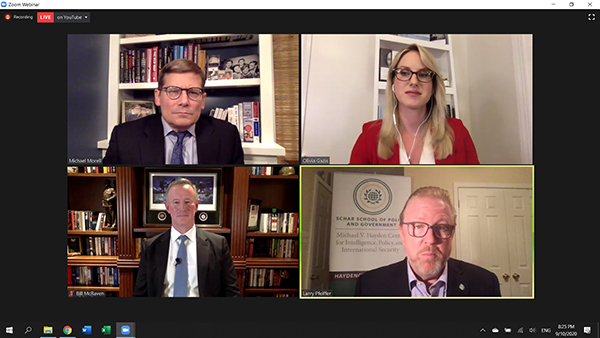Originally published on September 11, 2020
“I left my little make-shift command center. I went out to see the SEALs and they were around a fire pit… I knew exactly what needed to be said: ‘Since 9/11, all of you guys have dreamed about being the man that goes on the mission to get bin Laden. Well, this is the mission, and you are the men.’”
—Admiral (ret.) William McRaven
Ten years after former acting director of the CIA Michael Morell first briefed President Obama about the possible location of where America’s most-wanted terrorist might be hiding—and on the eve of the 19th anniversary of the 9/11 attacks—he took the virtual stage with William McRaven, retired Navy admiral and former commander of American Special Forces, to discuss the how they brought Osama bin Laden to justice.
See a recording of the conversation.
They described the sequence of events that led to bin Laden’s death to a crowd of over 500 people attending the 90-minute virtual event hosted by the Michel V. Hayden Center for Intelligence, Policy, and International Security at the Schar School of Policy and Government. The conversation was moderated by Olivia Gazis, a reporter for CBS News who helps with the production of Intelligence Matters, a podcast hosted by Morell. Morell is a Distinguished Visiting Professor at the Schar School.
Morell began by recounting the significance of a man named Abu Ahmed al-Kuwaiti, who multiple detainees said was a courier for bin Laden and was close to Khalid Sheikh Mohammed, the mastermind behind 9/11. Khalid Sheikh Mohammed, who was captured, said he had never heard of Abu Ahmed, but after his interrogation, Morell recounted, he told his cellmates not to say anything about “the courier.” “We obviously had the cell bugged,” said Morell.
After that, Morell said, the hunt for Abu Ahmed was on.
“It took us two or three years [after 2003] to figure out his true name. It took us another couple of years to find out his phone number,” Morell recalled. “Once we had his phone number, it was pretty easy to locate him on the planet, and we found him in Pakistan. Over a period of time we followed him to this compound in Abbottabad.”
Morell was then briefed by CIA officers in August of 2010. “Nobody at that meeting said the words ‘bin Laden might be there’ but everybody was thinking that.”
Given the complexity of the raid, the CIA reached out to McRaven and his Special Forces—the SEALs were chosen because of their experience in similar raids—to take charge of the operation, McRaven remembered. The teamwork among all the entities involved—intelligence and military—was crucial to the success. “All of the tactical details that we had to know for the operation, the Agency was providing that for us in order to develop the plan,” McRaven said.
Both Morell and McRaven recounted the humble nature and ego-free professionalism of everyone involved, and the level of trust and cooperation between the CIA and Special Forces.
“We were, in fact, one team,” said McRaven. “We knew this mission was too important to be anything but one team.”

